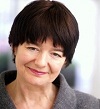Kim Franklin QC – Crown Office Chambers, London
 When Kim Franklin was appointed Queen’s Counsel at the ceremony at Westminster Hall in February 2016 it was the fulfilment of a childhood ambition. She wanted to be a barrister when she was 11 years old and kept that resolve despite leaving home at 16 and supporting herself through her studies – working as a cocktail waitress, motorcycle courier and legal secretary. She was grant-funded at university and bar school. Nevertheless in the 1980’s, as a state-educated, non-Oxbridge woman, Kim was in a minority when she started practice in a specialist construction chambers. Throughout her career, Kim feels that her non-traditional background has divided opinion. Some colleagues admired her determination and drive while others she felt were fearful and prejudiced. Kim is no stranger to discrimination but she believes that her experiences have operated to her advantage, making her a more resilient, resourceful and adaptable professional.
When Kim Franklin was appointed Queen’s Counsel at the ceremony at Westminster Hall in February 2016 it was the fulfilment of a childhood ambition. She wanted to be a barrister when she was 11 years old and kept that resolve despite leaving home at 16 and supporting herself through her studies – working as a cocktail waitress, motorcycle courier and legal secretary. She was grant-funded at university and bar school. Nevertheless in the 1980’s, as a state-educated, non-Oxbridge woman, Kim was in a minority when she started practice in a specialist construction chambers. Throughout her career, Kim feels that her non-traditional background has divided opinion. Some colleagues admired her determination and drive while others she felt were fearful and prejudiced. Kim is no stranger to discrimination but she believes that her experiences have operated to her advantage, making her a more resilient, resourceful and adaptable professional.
As a barrister specialising in construction and engineering law, Kim works on massive infrastructure project cases. She used to appear regularly in the Technology & Construction Courts, but is increasingly involved in high-value, complex adjudications and international arbitrations.
Kim is described by practitioners as ‘a true construction expert’, ‘a measured and powerful advocate’ with ‘a great deal of energy and endless patience’. Kim feel that she demonstrated her tenacity in applying for silk, through a process which she believes does not favour specialist practitioners, particularly women. She readily admits that she nearly gave up after her last unsuccessful attempt. She believes there are reputational risks with an unsuccessful application and that the requirements of the current process are such that you cannot keep the application secret. The burden on assessors is not to be underestimated. So it was with a mixture of “relief and delight” that she was successful in the 2015/16 competition. But her experience has informed a number of criticisms of the selection process and ideas as to how it could be improved in the future.
Kim found the feedback she received after her first application helpful. It provided a balanced review – identifying a shortage of High Court trial advocacy experience as case leader. This encouraged her to assume more advocacy roles, even when being led. But she found subsequent feedback “inherently discouraging”, focussing on the negative with criticisms that she felt were not relevant to the selection criteria and to which she had no opportunity to respond. Kim says that she experienced some feedback as so damning that she wondered whether it was intended to put her off, not just from re-applying but continuing to practice as a barrister.
We discussed diversity. Kim believes that women face disadvantages in the QC application process. Women still tend to be the primary carer, even when they are also the main ‘bread winner’. The dual demands on their time reduce their capacity to take on the case load required for the selection process – a drawback that colleagues without primary care responsibilities or with non-working partners do not have to overcome.
In the recent competitions, as a proportion of applicants, women were somewhat more successful that men. This suggests that when they do apply, women are better able to satisfy the competencies. But while women were proportionately more successful, the total number of women applying and being appointed remains “disappointingly low”. Kim suggested that that problem lay with the process itself. Women tend to need encouragement and support to promote themselves, and are generally less comfortable with the self-assessment process which requires the applicant to ‘blow their own trumpet’. They are more team-orientated and identify professional achievements in terms of “we” rather “I”. These qualities make women less likely to put themselves forward and to undermine their applications when they do, she says. They may also be reluctant to re-apply if unsuccessful, particularly if the feedback is “cutting or demoralising”. As Kim put it, it is hard enough to maintain the drive to acquire sufficient professional experiences to satisfy the selection criteria, while running a home as a single parent with teenage children. It is doubly hard to maintain that drive after “a kick in the teeth”.
Kim considers that self-evidently the QC selection process favours advocates who appear regularly in different courts and gain exposure to the requisite number of judicial assessors. She suggests that the Panel should make greater allowance for the fact that modern case management is designed to keep dispute resolution out of court. Increasingly, successful advocates work outside the courtroom – drafting, advising on evidence and in negotiation, mediation and construction adjudication. Kim said that the TCC and other specialist practitioners find it “all but impossible” to conduct twelve cases in front of twelve different judicial assessors in a two year period.
Kim recognised that the Panel no longer asks for more than eight judicial assessors and is prepared to accept fewer, subject to a ‘suitable explanation’ – including the nature of practice, exceptionally lengthy cases, time-out for maternity leave, carer responsibilities, sabbaticals and ill-health. Applicants may also go back three years or more to identify suitable cases of substance, if necessary. But, in Kim’s view, those adaptations of the process are not common knowledge and the widely held perception of the ’12 Judges’ rule discourages applicants.
Kim considered that applicants practicing in specialist courts, such as the TCC are also disadvantaged by the relatively limited number of specialist judges and practitioners – where everyone has known everyone else for some time. The selection process generally precludes applicants from relying on evidence outside a two or three year period. But there is no such limit on assessors. There is a danger therefore, Kim believes, that assessors in specialist courts have undue influence over the process, which would seem inimical to a system intended to replace the old ‘tap on the shoulder’. And that it would be wrong, for example, if the TCC judges pooled their views on applicants, irrespective of whether they had appeared before them recently, then ranked them before recommending them to the Panel. I pointed out that, although such lists had been sent to QCA in the past, they had never been forwarded to the Selection Panel members who make all the decisions on applicants. Kim felt that this did not overcome the main problem which was that a non-assessor judge could influence the assessment with reference to non-relevant material – without the Panel knowing.
The application process is particularly daunting for barristers. They are self-employed and do not have the review and mentoring systems enjoyed by corporate employees. It should come as no surprise therefore in Kim’s view that barristers seek advice on completing the application form and training for their interview. Kim considers that applicants would be ill-advised to proceed without training because, in the main, barristers do not speak ‘HR’. And, in her view, not all Panel members understand what practising as a barrister in a set of chambers entails. She said that one feedback from the Panel, for example, appeared to criticise her because her chambers ‘lagged behind other parts of the Bar on diversity issues’.
Turning to the selection interview, Kim considered that most people are surprised that it is “only” 35-40 minutes, particularly as the Panel had reported that only those applicants who were potentially appointable were interviewed. If the objective is to address reasons why the application ought not to succeed, a 35-40 minute interview seemed “ludicrously short”. She found anonymised criticisms of her application particularly difficult to address when presented without context. For example ‘It is said that you didn’t cross examine an expert with reference to examples – can you comment?’ Kim found it particularly challenging to conduct an interview with individuals who she felt had “no appreciation of the specialist work” she does. She pointed out that for her successful application she was interviewed, for the first time, by a commercial silk with some experience of complex international construction disputes.
Kim had concerns about how assessors other than the ‘nominated’ assessors were selected. When she identified a member of the Supreme Court as an assessor she was “gob-smacked” to learn that they had not been approached. This suggested to Kim that the selection was made without appreciating that it was exceptional for junior counsel to appear in the Privy Council. I explained that various criteria were used to select assessors from those listed by the applicant, such as the substance of the case, the prospects of getting good information from the assessor, especially on the understanding and using the law and advocacy competencies, how recent it was and the forum in which it took place. The underlying principle was to select those assessors who, from the information listed on the application form, appeared likely to have the most useful information about each applicant. Kim pointed out, however, that as the Panel has reported that it limits the number of assessments from the senior judiciary, there is “an element of luck” involved, as was demonstrated when an assessment was sought from the same judge, for the same case for her successful application.
Looking to the future, Kim would like the Panel to adopt a “more realistic” approach and to examine its own processes “with some of the rigour it applies to applicants”. She would like it to advertise minimum criteria to dispel the ’12 Judges’ rule, to extend the interview to 50 minutes, to give more balanced feedback and avoid damning comments unless they go directly to the competencies. She would like to see the profession doing more in the way of formal mentoring of applicants by those who have successfully negotiated the QC application process. Kim would be happy to be involved in a mentoring scheme, particularly for women, to provide the encouragement and support they need to see the process through.
If you are thinking of applying for silk, Kim said, it can be something an ordeal. Be sure that you want it and can work to overcome what Kim strongly considers to be hurdles presented by the process. She used to say ‘if you’ve got £2K to blow, can spare a fortnight for the form and fancy a good drubbing – apply for silk’. But having decided that she wanted to enhance her practice and make a difference in chambers she refused to give up. There is no doubt that QC counts for something. Immediately she was treated differently in chambers and has already been approached with international arbitration appointments. She is beginning to realise the importance of her new role and is keen to put it to good use – particularly if she can address some of the shortcomings she perceives in the selection process and make it easier for good applicants to succeed in the future.
© Queen’s Counsel Appointments Ltd
QCA Footnote on Mentoring:
The Bar Council currently offers three different mentoring schemes designed to support individuals at different point in their career including ‘Scheme 1’ which supports established barristers seeking judicial appointment or considering applying for Silk. Mentors are all volunteers and members of the Bar. Here is a link http://www.barcouncil.org.uk/supporting-the-bar/bar-mentoring-service/silk-and-judicial-appointments/ The Association of Women Barristers also has a mentoring programme provided by and for its members. See http://www.womenbarristers.com/#!mentor/csee
- Date: March 25, 2019
- Category: QCA Profiles 2016


